
|
Top 50 Underappreciated Recent Films45) Barn of the Blood Llama
All I can tell you about the "plot" is that it involves a group of women and a rock star who end up at the "World O Wool," a tourist trap in Texas run by two yokels named Jug and Gibby. Inside, a Dr. Albert is conducting - uhm, shall we say - "genetic experiments" on llamas. Once you realize that the script is not going to advance any kind of story line, you can then sit back and enjoy the sheer number of bizarre, highly quotable non sequitors it contains. My favorite of the moment: "We've all just been through a living hell. So haggis is on the house!" The film itself switches from color to black and white, from video to 8mm. All of the dialogue is badly dubbed, and the whole thing looks and sounds as if it was put together in a local public access studio. And of course, the "effects" are among the very worst I have seen -- I could swear that the "llama" that gets hit by a car early in the film is actually a roll of shag carpeting. But no matter. Barn of the Blood Llama is a freakshow that wallows so gleefully in its own badness that you cannot help but go along for the ride, if only to see what could possibly be thrown at you next. If the filmmakers weren't on crack, you will swear, about fifteen minutes into this movie, that you are. (Tad Roebuck/BOP) 44) The Quick and the Dead
Why did it fail? Apart from the fact that (Unforgiven aside) the western simply does not appeal to the cinema-going hordes any more, I suspect there was an unwillingness to accept the glamorous Sharon Stone as a gritty and dangerous action lead. Despite a valiant performance and dedication to the film, she still sticks out like a sore thumb. (Ash Wakeman/BOP) 43) The Frighteners
To go much into the plot would be to spoil some of the enjoyment of this film. Suffice it to say that The Frighteners' plot has surprising depth, with enough twists and turns to make M Night Shyamalan proud; enough genuine scares to please most horror fans employed with a gentleness that also suits more timid audiences; and three-dimensional characters worthy of any Oscar-winning drama. Add in just a dash of black comedy, some wonderful acting, and you've got a nifty concoction that is more than worth the effort of trotting down to your local rental establishment and picking up a copy of this overlooked little gem. You'll be rewarded with an intriguing study of the spirit world, those who make a living helping us connect with it, and the consequences of one's actions in both this world and the next. (Stephanie Star Smith/BOP) 42) Before Sunrise
Short of the physical comeliness of the two leads, it's almost as un-stereotypically Hollywood as you can get. There are no colorful comedy-relief friends, no frowning family members opposing the relationship, no happenstance encounters which repeatedly thrust two diametrically-opposite personalities into a wacky crucible which inevitably must forge a perfect romance by the final reel. Instead, they talk. About themselves, about dreams, about art, about relationships, about the dynamics of men and women, about each other. Throughout their conversations, you can track the entire evolution of a relationship, from attraction to flirtation to growing respect to understanding to romance. The audience is not so much told why these characters like each other as they simply understand it. The key to the characters' chemistry is the vision of writer/director Richard Linklater. As a writer, Linklater has penned an intelligent screenplay about intelligent characters who have opinions and desires and are able to express them. As a director, he elicits performances which are so charming and natural, we forget that they're written. It is likely that the above description has reaffirmed in many readers' minds why this film remains unappreciated, and it's true. Those moviegoers who need to be spoon-fed their love stories between one-dimensional characters with big-name actors, sappy soundtracks, and logic-defying contrivances will likely find no entertainment value here. But hopefully, those who managed to read through this without shuddering at yet another art-house flick will know better and take prompt steps to rectify their mistake. (Kevin Chen/BOP) 41) George Washington
Click here to read selections 50-46.
|
Saturday, November 15, 2025
© 2006 Box Office Prophets, a division of One Of Us, Inc.
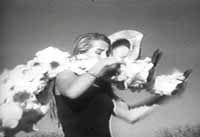 Bad movies are, by definition, underappreciated. And Barn of the Blood Llama
IS bad. Very, very, very bad. But it's the best damned bad movie this side
of Pink Flamingos that I have seen in ages.
Bad movies are, by definition, underappreciated. And Barn of the Blood Llama
IS bad. Very, very, very bad. But it's the best damned bad movie this side
of Pink Flamingos that I have seen in ages.
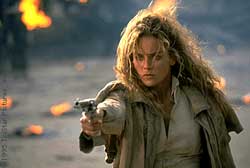 Many people saw Eastwood's award-winning Unforgiven as the nail in the
coffin for the traditional western, as it showed a more realistic side of
the Old West and the violence the genre glorifies. Sam Raimi, however,
chose to ignore that message and instead created a gritty but cartoon-like
western that reveled in every cliché in the book. In doing so, he made a
modern western that was everything Silverado and Maverick (the movie) were
not. The film is a simplistic tale of revenge set during a dueling contest
in a small town ruled by a corrupt sheriff. To be fair, there is nothing
even vaguely original in the plot or script. But the premise gives Raimi an
excuse to go to town with his trademark cinematography during the regular
shootouts. Great performances all round from Gene Hackman, reprising his
corrupt sheriff from Unforgiven, to Leonardo DiCaprio while he was still
living up to the hype, to the enigmatic Russell Crowe, giving us a glimpse of
what was to come. On top of this is a delightful collection of
well-observed Western clichés who show up for the contest.
Many people saw Eastwood's award-winning Unforgiven as the nail in the
coffin for the traditional western, as it showed a more realistic side of
the Old West and the violence the genre glorifies. Sam Raimi, however,
chose to ignore that message and instead created a gritty but cartoon-like
western that reveled in every cliché in the book. In doing so, he made a
modern western that was everything Silverado and Maverick (the movie) were
not. The film is a simplistic tale of revenge set during a dueling contest
in a small town ruled by a corrupt sheriff. To be fair, there is nothing
even vaguely original in the plot or script. But the premise gives Raimi an
excuse to go to town with his trademark cinematography during the regular
shootouts. Great performances all round from Gene Hackman, reprising his
corrupt sheriff from Unforgiven, to Leonardo DiCaprio while he was still
living up to the hype, to the enigmatic Russell Crowe, giving us a glimpse of
what was to come. On top of this is a delightful collection of
well-observed Western clichés who show up for the contest.
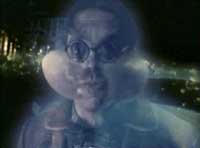 The Frighteners is a film that's hard to pigeonhole, which is likely why it
didn't do so well in its theatrical release. It stars Michael J Fox, but
it's not an out-and-out comedy. It centers on the spirit world, but it's
not your typical horror film. It deals with loss and grief, but not in
heavily-dramatic terms. A marketing department nightmare to be sure, but
its very uniqueness is what makes it worth two hours of your time.
The Frighteners is a film that's hard to pigeonhole, which is likely why it
didn't do so well in its theatrical release. It stars Michael J Fox, but
it's not an out-and-out comedy. It centers on the spirit world, but it's
not your typical horror film. It deals with loss and grief, but not in
heavily-dramatic terms. A marketing department nightmare to be sure, but
its very uniqueness is what makes it worth two hours of your time.
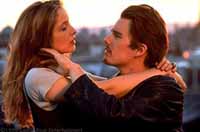 It's an age-old tale: Boy meets girl on train, boy convinces girl to get
off train, boy has a series of conversations with girl before departing for
home thousands of miles away, presumably never to be seen again. The boy in
this case is Jesse (Ethan Hawke), a cynical American slacker spending his
last day in Europe before his return flight home from Vienna. The girl is
Celine (Julie Delpy), a French student also returning home, but to Paris.
It's an age-old tale: Boy meets girl on train, boy convinces girl to get
off train, boy has a series of conversations with girl before departing for
home thousands of miles away, presumably never to be seen again. The boy in
this case is Jesse (Ethan Hawke), a cynical American slacker spending his
last day in Europe before his return flight home from Vienna. The girl is
Celine (Julie Delpy), a French student also returning home, but to Paris.
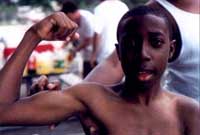 David Gordon Green's story of confusing childhood and sweltering place is
simply one of the most revelatory and original movies to come out of the
American independent cinema in quite some time. Stunningly photographed and
shot at a near-perfect, almost languorous pace, this film truly should have
garnered far more recognition than it did during the year in which it
debuted. Unfortunately, while it created something of a critical stir at
its release, the film never really found an audience - and, as far as I
know, never found a distributor willing to take a chance on it - in
theaters. The essential plotlessness of the outing couldn't have helped in
trying to sell the film on what passes for an art-film circuit these days,
but it's a real shame that there wasn't somebody out there willing to commit
to this breathtaking and intelligent look at adolescence. Given the great
work of the ensemble cast, the deft touch of the director and the movie's
overall innovative style, one might have hoped that a film such as George
Washington could have been given the chance to reach a wider audience.
Since it stands as one of the best films on children to have been made in
the last 20 years, as well as one of the most individually imaginative films
of any stripe to appear recently from the American independent scene, it
certainly deserved a much better fate. (Chris Hyde/BOP)
David Gordon Green's story of confusing childhood and sweltering place is
simply one of the most revelatory and original movies to come out of the
American independent cinema in quite some time. Stunningly photographed and
shot at a near-perfect, almost languorous pace, this film truly should have
garnered far more recognition than it did during the year in which it
debuted. Unfortunately, while it created something of a critical stir at
its release, the film never really found an audience - and, as far as I
know, never found a distributor willing to take a chance on it - in
theaters. The essential plotlessness of the outing couldn't have helped in
trying to sell the film on what passes for an art-film circuit these days,
but it's a real shame that there wasn't somebody out there willing to commit
to this breathtaking and intelligent look at adolescence. Given the great
work of the ensemble cast, the deft touch of the director and the movie's
overall innovative style, one might have hoped that a film such as George
Washington could have been given the chance to reach a wider audience.
Since it stands as one of the best films on children to have been made in
the last 20 years, as well as one of the most individually imaginative films
of any stripe to appear recently from the American independent scene, it
certainly deserved a much better fate. (Chris Hyde/BOP)